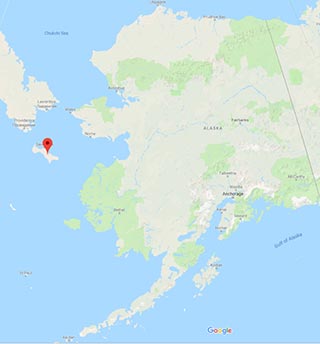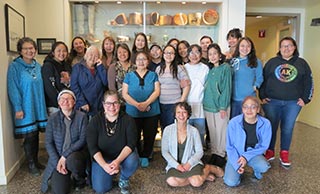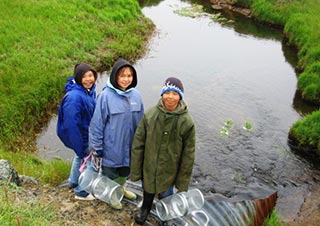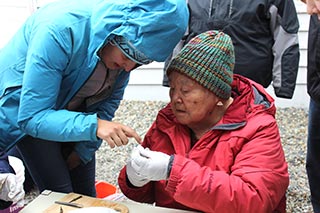Studying Exposure to Legacy Contaminants and Health Effects on Sivuqaq (St. Lawrence Island)
Project Overview
The Alaska Community Action on Toxics (ACAT), a community-based organization, leads a collaborative project with academic environmental health researchers and community members of the indigenous Yupik people of St. Lawrence Island, known by the traditional name Sivuqaq, in Arctic Alaska. They are investigating exposure to legacy contaminants and emerging flame-retardant chemicals and effects on the endocrine system and child development.
The goals of the project are to:
- Empower Sivuqaq communities with data and tools to address health disparities
- Inform public health interventions
- Improve health outcomes of Arctic children and communities broadly
- Reduce future exposure of Sivuqaq children to toxic substances
- Increase understanding of routes of exposure and health effects on Sivuqaq children
Background

Sivuqaq (St. Lawrence Island) lies west of mainland Alaska and just 36 miles from Russia. It is about 1,700 square miles and has a population of nearly 1,300.
(Photo courtesy of Google Maps)
Sivuqaq lies west of the Alaskan mainland and south of the Bering Strait. This small, remote island is home to two now-abandoned Cold War-era military bases, which are contaminated with polychlorinated biphenyls (PCBs), fuel, solvents, pesticides, lead, mercury, asbestos, and more. Residents are concerned because these legacy contaminants remain in the environment.
In addition, the Sivuqaq region is disproportionally exposed to other toxic chemicals, including persistent organic pollutant (POPs), through global transport. POPs, which include flame-retardant chemicals and pesticides that are released into the environment in other parts of the world, accumulate in the Arctic, contaminating animals, plants, soil, and water. POPs can even get into dust in homes. Small children may come into direct contact with this dust by playing on the floor and putting things in their mouths.
These legacy contaminants and POPs have significantly affected and continue to threaten the health and well-being, as well as the cultural practices, of St. Lawrence residents.
The native Yupik people rely on hunting and fishing for food and traditional practices; consequently, they must choose to increase their exposure or avoid these cultural practices. In one case, runoff of contaminants from a military site made the Suqi River, once an abundant source of salmon, uninhabitable for fish.
Most recently, increasing temperatures in the Arctic further challenge residents to maintain adequate food supplies. Traditional hunters have not been able to bring home the necessary food for their families and communities.
Citizen Involvement

In 1997, community activists concerned about environmental health issues created ACAT. As a community-based organization, ACAT works closely with Alaska Native tribes, health care professionals, students, teachers, and scientists to protect health and conduct community-based participatory research (CPBR). CBPR approaches can help inform policy and clean-up strategies by providing scientific data and engaging and empowering citizens. ACAT also conducts education and outreach programs and works to achieve protective public health policies at the local, state, national, and international levels.
On Sivuqaq, ACAT worked with a community health aide and respected elder, Annie Alowa, to address growing health concerns among the local population. This collaboration led to a series of federal grants from NIEHS to assess contamination levels.
The tribes of Sivuqaq collect and help analyze sediment cores from the Suqi River, plants, meat and blubber samples, as well as personal blood samples and household dust samples in partnership with ACAT, the University at Albany, Northern Arizona University, Indiana University, the University of Alaska, the University of Oregon, and the Wadsworth Laboratory. Tribal leaders have worked with the CBPR team to share research results with the community in culturally appropriate ways.

Tribal members are also involved in capacity-building events. ACAT conducts a community-based environmental health research institute, which offers college credits for classroom and field experiences related to methods for field research, including water quality, air monitoring, soil and sediment sampling, and biological monitoring. They also organize workshops, webinars, community forums, and environmental health fairs to disseminate information about best practices for conducting research, protecting and improving health, and collecting clinical health information. Often fun and cultural, events may involve traditional drumming and dancing, activities for children, and dinner with traditional foods.
Outcomes
Military sites clean-up. Because of efforts by ACAT and the Sivuqaq community, the U.S. Army Corps of Engineers established a Restoration Advisory Board, which provides a regular forum for Sivuqaq community members to review, comment, and advise on the clean-up process of the abandoned military sites. Over $200 million has been spent on removal and remediation at the two sites.

Additions to scientific knowledge. As a result of the collaboration, ACAT staff and the academic partners have published results of their CBPR research in peer-reviewed scientific journals, demonstrating its value as legitimate science.
Informing health policy. Data from this collaboration have helped inform policies to better protect human health. For example, a delegation of 16 Sivuqaq community leaders traveled to Washington, D.C., to brief federal officials at the Departments of Defense and State, the NIEHS, and the U.S. Environmental Protection Agency (EPA), as well as members of Congress. One outcome was the EPA committing to establishing an ongoing, formal Sivuqaq Dialogue Group composed of state and federal agencies, Sivuqaq tribal governments, the Alaska Native Tribal Health Consortium, ACAT, and collaborating scientists.
ACAT and the Sivuqaq community also helped inform changes to the federal Toxic Substances Control Act with passage of The Frank R. Lautenberg Chemical Safety for the 21st Century Act through extensive public education, engagement of health care professionals, support of Native tribes and organizations such as the Alaska Federation of Natives, and work with members of Congress.
Internationally, the partners have supported negotiation and implementation of the Stockholm Convention on Persistent Organic Pollutants, a legally binding treaty ratified by 182 countries to ban some of the most hazardous chemicals. The treaty specifies the vulnerability of Arctic ecosystems to pollutants originating at lower latitudes. They also participate in the Global Indigenous Peoples Caucus, which convenes during the Stockholm Convention on POPs, and the International Pollutants Elimination Network.
Challenges
Working with former military sites. The clean-up of abandoned military sites is a long-term project. It requires patient, ongoing effort by ACAT to work with the military in reviewing and advising on project complexities.
Addressing effects of global pollution in the Arctic. Tackling the global scale of contaminants requires international efforts, such as the Stockholm Convention, but not all countries and organizations are signatories.
Working with limited time resources. Community engagement may vary due to individuals’ time constraints, as they also must work, raise families, and attend school. Therefore, ACAT has challenges in conducting CBPR that requires large time commitments by community members.
Contact
-
Pam Miller
Executive Director;
Alaska Community Action on Toxics -
Tel 907-222-7714
[email protected]
Related Information
- Byrne SC, Miller P, Seguinot-Medina S, Waghiyi V, Buck CL, von Hippel FA, Carpenter DO. 2018. Associations between serum polybrominated diphenyl ethers and thyroid hormones in a cross sectional study of a remote Alaska Native population. Sci Rep 8(1):2198. [Full Text Byrne SC, Miller P, Seguinot-Medina S, Waghiyi V, Buck CL, von Hippel FA, Carpenter DO. 2018. Associations between serum polybrominated diphenyl ethers and thyroid hormones in a cross sectional study of a remote Alaska Native population. Sci Rep 8(1):2198.]
- Byrne SC, Miller P, Seguinot-Medina S, Waghiyi V, Buck CL, von Hippel FA, Carpenter DO. 2018. Exposure to perfluoroalkyl substances and associations with serum thyroid hormones in a remote population of Alaska Natives. Environ Res 166:537-543. [Abstract Byrne SC, Miller P, Seguinot-Medina S, Waghiyi V, Buck CL, von Hippel FA, Carpenter DO. 2018. Exposure to perfluoroalkyl substances and associations with serum thyroid hormones in a remote population of Alaska Natives. Environ Res 166:537-543.]
- von Hippel FA, Miller PK, Carpenter DO, Dillon D, Smayda L, Katsiadaki I, Titus TA, Batzel P, Postlethwait JH, Buck CL. 2018. Endocrine disruption and differential gene expression in sentinel fish on St. Lawrence Island, Alaska: health implications for indigenous residents. Environ Pollut 234:279-287. [Full Text von Hippel FA, Miller PK, Carpenter DO, Dillon D, Smayda L, Katsiadaki I, Titus TA, Batzel P, Postlethwait JH, Buck CL. 2018. Endocrine disruption and differential gene expression in sentinel fish on St. Lawrence Island, Alaska: health implications for indigenous residents. Environ Pollut 234:279-287.]
- Byrne S, Seguinot-Medina S, Miller P, Waghiyi V, von Hippel FA, Buck CL, Carpenter DO. 2017. Exposure to polybrominated diphenyl ethers and perfluoroalkyl substances in a remote population of Alaska Natives. Environ Pollut 231(Pt 1) 387-395. [Abstract Byrne S, Seguinot-Medina S, Miller P, Waghiyi V, von Hippel FA, Buck CL, Carpenter DO. 2017. Exposure to polybrominated diphenyl ethers and perfluoroalkyl substances in a remote population of Alaska Natives. Environ Pollut 231(Pt 1) 387-395.]
- Byrne S, Miller P, Waghiyi V, Buck CL, von Hippel FA, Carpenter DO. 2015. Persistent organochlorine pesticide exposure related to a formerly used defense site on St. Lawrence Island, Alaska: data from sentinel fish and human sera. J Toxicol Environ Health A 78(15):976-992. [Full Text Byrne S, Miller P, Waghiyi V, Buck CL, von Hippel FA, Carpenter DO. 2015. Persistent organochlorine pesticide exposure related to a formerly used defense site on St. Lawrence Island, Alaska: data from sentinel fish and human sera. J Toxicol Environ Health A 78(15):976-992.]
- Miller PK, Waghiyi V, Welfinger-Smith G, Byrne SC, Kava J, Gologergen J, Eckstein L, Scrudato R, Chiarenzelli J, Carpenter DO, Seguinot-Medina S. 2013. Community-based participatory research projects and policy engagement to protect environmental health on St Lawrence Island, Alaska. Int J Circumpolar Health 72:21656. [Full Text Miller PK, Waghiyi V, Welfinger-Smith G, Byrne SC, Kava J, Gologergen J, Eckstein L, Scrudato R, Chiarenzelli J, Carpenter DO, Seguinot-Medina S. 2013. Community-based participatory research projects and policy engagement to protect environmental health on St Lawrence Island, Alaska. Int J Circumpolar Health 72:21656.]
- Hoover E, Cook K, Plain R, Sanchez K, Waghiyi V, Miller P, Dufault R, Sislin C, Carpenter DO. 2012. Indigenous peoples of North America: environmental exposures and reproductive justice. Environ Health Perspect 120(12):1645-1649. [Full Text Hoover E, Cook K, Plain R, Sanchez K, Waghiyi V, Miller P, Dufault R, Sislin C, Carpenter DO. 2012. Indigenous peoples of North America: environmental exposures and reproductive justice. Environ Health Perspect 120(12):1645-1649.]
- Scrudato RJ, Chiarenzelli JR, Miller PK, Alexander CR, Arnason J, Zamzow K, Zweifel K, Gologergen J, Kava J, Waghiyi V, Carpenter DO. 2012. Contaminants at Arctic formerly used defense sites. Journal of Local and Global Health Science 2012(1). [Full Text Scrudato RJ, Chiarenzelli JR, Miller PK, Alexander CR, Arnason J, Zamzow K, Zweifel K, Gologergen J, Kava J, Waghiyi V, Carpenter DO. 2012. Contaminants at Arctic formerly used defense sites. Journal of Local and Global Health Science 2012(1).]
- Welfinger-Smith G, Minholz JL, Byrne S, Waghiyi V, Gologergen J, Kava J, Apatiki M, Ungott E, Miller PK, Arnason JG, Carpenter DO. 2011. Organochlorine and metal contaminants in traditional foods from St. Lawrence Island, Alaska. J Toxicol Environ Health A. 74(18):1195-1214. [Abstract Welfinger-Smith G, Minholz JL, Byrne S, Waghiyi V, Gologergen J, Kava J, Apatiki M, Ungott E, Miller PK, Arnason JG, Carpenter DO. 2011. Organochlorine and metal contaminants in traditional foods from St. Lawrence Island, Alaska. J Toxicol Environ Health A. 74(18):1195-1214.]
- Carpenter DO, DeCaprio AP, O’Hehir D, Akhtar F, Johnson G, Scrudato RJ, Apatiki L, Kava J, Gologergen J, Miller PK, Eckstein L. 2005. Polychlorinated biphenyls in serum of the Siberian Yupik people from St. Lawrence Island, Alaska. Int J Circumpolar Health 64(4):322-335. [Full Text Carpenter DO, DeCaprio AP, O’Hehir D, Akhtar F, Johnson G, Scrudato RJ, Apatiki L, Kava J, Gologergen J, Miller PK, Eckstein L. 2005. Polychlorinated biphenyls in serum of the Siberian Yupik people from St. Lawrence Island, Alaska. Int J Circumpolar Health 64(4):322-335.]


